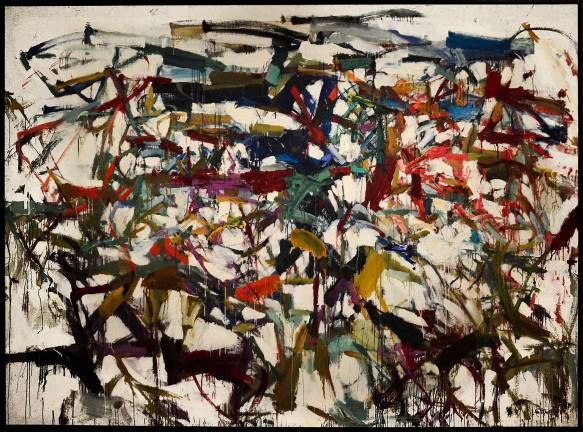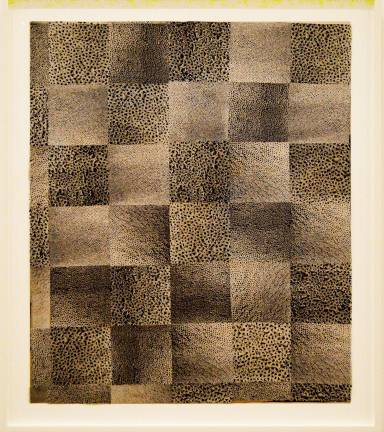Modern Girl Power








“Making Space,” MoMA’s exhibition focusing on women artists and postwar abstraction needs space, since the first piece pulls you from across the mezzanine and then knocks you back a few feet when you get to it. Grace Hartigan’s painting “Shinnecock Canal” (1957), towering at 7 and a half feet tall, announces that this isn’t a repository for dainty, docile, domesticated art.
In Hartigan’s composition, flowing ocean blue crashes into lawn green and cloud white, punctuated with drags of paint and sharp black lines. It proclaims the Long Island landscape for which it’s named by references rather than reproduction, and it’s as strong as any gestural abstraction done anywhere at the time. These women could paint (or sculpt or photograph or whatever they put their minds to) and did so with as much passion, focus and force as their male colleagues.
A small, perfectly balanced painting by Etel Adnan follows, and reveals that the exhibition, while tightly focused on the years between the end of World War II and the late 1960s, is international in outlook. Along with Adnan’s, look for works by stars like Yayoi Kusama (global by way of Japan), Brazilian Lygia Clark, and Cuba’s great export, Carmen Herrera, as well as by less familiar names such as Britain’s Bridget Riley and German-born Brazilian photographer Gertrudes Altschul.
The pieces are all culled from MoMA’s permanent collection, and the exhibition is organized by curators Starr Figura and Sarah Meister, with Hillary Reder, curatorial assistant. “It’s part of an institutional commitment to improve the representation of women artists in the collection,” Meister said.
“This show is not a beginning” Figura added. “It’s not an end. It’s one event in an ongoing process of looking at women artists and amplifying the way that they’re represented here at MoMA.”
Some of the strongest statements in the show are made by women of Abstract Expressionism. Elaine de Kooning, Helen Frankenthaler, Joan Mitchell and Hedda Sterne are all represented by outstanding works. Lee Krasner’s 1966 painting “Gaea” claims an entire wall and a place in history, not because of who she was married to — Jackson Pollock — but because her work is vibrant, vigorous, expressive and engaging.
While several of the women in “Making Space” were married to artists, all of them took it upon themselves to do what the title suggests. They found a way to make their voices part of the chorus of 20th century art. “It’s very difficult for women to find a place within the hyper-masculine world of Ab-Ex,” Figura said. “These women are trying to make space for themselves within a tradition of painting and sculpture that’s been dominated by men for centuries.” Like all artists, women made their work matter not by imitating but by innovating. We see that in Czech artist, Běla Kolářová’s “Five by Four” (1967), a witty, though serious and surprising composition. Here, the tiny, repetitive marks that form the gridded abstraction are actually metal paper fasteners affixed to the surface. They glisten, enlivening the work, and at the same time can be read as a wry commentary on the largely clerical role of women in offices at the time. Alma Woodsey Thomas’s collage of rainbow chips of color become a prism through which to view her ebullient spirit. Louise Nevelson’s towering construction, “Big Black,” is bold and insistent, claiming its own space, while Agnes Martin’s all-white quietude speaks just as clearly.
In the 1960s, a group of women made a new category for their work by reclaiming fiber, previously relegated to craft. Annie Albers wove fastidious studies in color and shape, and Sheila Hicks redefined how fiber can function. Rough, uneven surfaces and a sense of overwhelming weight drags Magdalena Abakanowicz’ s woven “Yellow Abakan” towards the floor, while across the room, Ruth Asawa’s airy, knotted sculpture, “Untitled,” hovers like a hummingbird.
With about 100 works by more than 50 international artists, nearly half of which are on view at MoMA for the first time, “Making Space: Women Artists and Postwar Abstraction” will surprise almost everyone. Some, with the realization that women artists in the 1940s, ‘50s and ‘60s around the world were creating works equal to and, at times, better than those by male counterparts. Others will be surprised to discover so many wonderful artists they’ve not met before and question why, since these are all in MoMA’s collection.
“By looking carefully at what we have, we become acutely aware of what we need to do,” Glenn Lowry, MoMA’s director, said. “The familiar is satisfying but less interesting ultimately to us than the unfamiliar ... which is what we have to find a way to foreground, so that those voices become part of a larger conversation.”
It’s wonderful to get a glimpse at these works and a chance to consider them. It would be great to see space made for them to hang on permanent display amidst works by Rothko, Pollock, Hofmann, Rauschenberg, Johns, Warhol and the rest of the guys.